The bright coloured petals and scents of flowers have evolved to maximise the chance of cross pollination by insects.
Lesser Celandine
The Lesser celandine is one of our early flowering plants. The yellow star shaped flowers and dark green shiny leaves brighten up woodland floors and let us know that Spring is on its way.
The name celandine is reported to come from the latin word chelidonia which means swallow. The flowers are in bloom when the swallows arrive and fade when the swallows fly back to warmer climes.
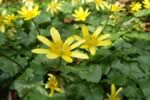
Flowers: March - May, only opens in sunshine, 20-30mm across, 8-12 shiny yellow petals and 3 sepals
Leaves: Heart- shaped, glossy,dark green
Habitat: Hedgerows and open woodland - grows in clumps
Height: 25cm
Fruit: In a rounded head
Status: Common
Latin Name: Ranunculus ficaria
Common Dog Violet
The common dog violet is such a pretty, violet coloured, flower and can be found hidding away in hedgerows, woodland and grass land. Often the yellow primrose, another common spring flower, can be found growing alongside violets, in the same habitat.
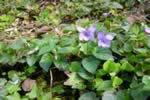
Flowers: March - May
Leaves: Heart-shaped, long-stalked and mainly hairless
Habitat: Woodland and grassland
Height: 12cms
Fruit: Egg-shaped
Status: Widespread and common
Latin name: Viola riviniana
Cuckoo Flower / Lady's Smock
The Cuckoo flower appears in April on damp or marshy ground. The petals come in delicate shades of lilac and white. The flower, also known as Lady's smock, is a favourite food source for the Orange tip butterfly.
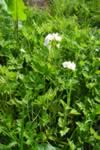
Flowers: April - June, 12-20mm across with 4 pale lilac or white flowers
Leaves: Basal rosette of pinnately divided leaves with rounded lobes, narrow stem
Habitat: Damp, grassy places
Height: 50cm
Fruit: Elonggated, beaked
Status: Widespread and common
Latin Name: Cardamine pratensis
Bluebell
One of the most lovely sights in Spring is a bluebell wood when the woodland carpet appears a hazy blue. Bluebells can be found throughout Lagan valley Regional Park. Belvoir Park Forest, Minnowburn and Barnett's Demesne are just three of the sites where it is worthwhile taking a stroll in springtime.
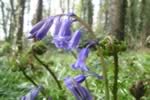
Flowers: April - June, bell-shaped, blueish purple
Leaves: Long, 15mm wide, glossy green
Habitat: Woodland
Height: 50cm
Fruit: Capsules
Status: Widespread, abundant
Latin Name: Hyacinthoides non-scripta
Cow Parsley
Cow parsley is found in such abundance throughout Lagan Valley Regional Park that it is worth a mention. The tall creamy white flowers are a harbinger of
summer and attract lots of insects.
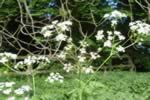
Flowers: April - June, White, in umbels up to 6cm across
Leaves: 2-3 times pinnate, slightly hairy, fresh green
Habitat: meadows, woodland margins and verges
Height: 1m
Fruit: Elongate, ridged
Status: Widespread and common
Latin Name: Anthriscus sylvestris
Dog Rose
The Dog rose has a delicate, pale pink flower with a beautiful scent. We are then rewarded again in the autumn with a wonderful display of bright red rosehips.
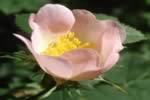
Flowers: June/July, 3-5 cm across, fragrant with 5 pale pink petals and yellow stamens
Leaves: 5 - 7 hairless leaflets
Habitat: Hedgerows
Height: Scrambling shrub 3m high
Fruit: Red, egg-shaped hips
Status: Common
Latin Name: Rosa Canina
Honeysuckle
Honeysuckle twines itself through hedgerows and woodland and provides us with a delicate, soft creamy flower in shades of yellow and peach. It can be seen in many areas throughout the Park and gives out a beautiful perfume. In the autumn bright red berries appear through the foliage to brighten up our hedgerows.
Flowers: June- August, 3-5cm long, scented, trumpet-shaped,creamy yellow to white
Leaves: Grey-green, oval, in opposite pairs
Habitat: Woodland scrub and hedgerows
Height: up to 5m - woody climber
Fruit: Red berries in clusters
Status: Widespread and common
Latin Name: Lonicera periclymenum
Foxglove
Foxgloves provide clumps of purple colour along woodland and roadside edges. They flower in tall spikes with individual flowers in the shape of a trumpet.
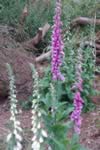
Flowers: June - September, 10-15mm across, pinkish purple corolla with 5 lobes, in tall spikes
Leaves: 20-30cm long, downy, oval, wrinkled
Habitat: Woodland, moors and sea cliffs
Height: 1.5m
Fruit: Green capsules
Status: Widespread and common
Latin Name: Digitalis purpurea
Creeping Thistle
The Creeping thistle is worth a mention as it provides colour late in the summer when the majority of summer flowers have turned to seed. The seed is spread as thistledown by the wind.

Flowers: June- Sept, 10-15 mm across with pinkish-lilac florets and darker bracts; heads in clusters
Leaves: Pinnately lobed,spiny
Habitat: Disturbed ground and grassy areas
Height: 1 m
Fruit: With feathery pappus hairs
Status: Widespread and common
Latin Name: Cirsium arvense







